Terry I (Destroyer No. 25)
1910-1930
Edward A. Terry -- born at Hartford, Conn., to Edward Terry and Sophia (née Pollack) on 24 January 1839 -- was appointed acting midshipman on 21 September 1853 and midshipman on 10 June 1857. He served in the sloop Germantown, attached to the East India Squadron, from 1857 to 1859. He was promoted to passed midshipman on 25 June 1860, and shortly thereafter, master on 24 October 1860. Less than six months later, on 3 April 1861, he was promoted to lieutenant. By 1861, he was assigned to the steam sloop Richmond and served on board her with the West Gulf Blockading Squadron throughout the Civil War, participating in the engagement with the Confederate ram Manassas on 12 October 1861, the artillery duel with Fort McRae and other shore batteries on 22 November, and in late April 1862, in the passage of Forts Jackson and St. Philip, La., and the capture of New Orleans, La.
Subsequently, Rear Adm. David G. Farragut’s force ascended the Mississippi River. Terry was present when the fleet ran the gauntlet at Vicksburg and joined Capt. Charles H. Davis’ riverine fleet above the Confederate stronghold. On 4 January 1863, Terry received promotion to lieutenant commander. His ship, on 14 March, joined the others of the fleet in bombarding the batteries surrounding Port Hudson, La., so that Farragut’s squadron could dash past them and establish a blockade cutting the Confederacy’s Red River supply line. In his last major engagement, the Battle of Mobile Bay on 5 August 1864, Terry helped to close the last major Confederate port on the Gulf of Mexico.
Following the Civil War, Terry alternated between sea duty and a series of shore assignments at the Naval Academy. After the war, he served in the Pacific Squadron in the steam frigate Powhatan (1866-1867). His first tour of duty at the Naval Academy followed in 1868-1869. He assumed his first command, the gunboat Saco, in 1870 and cruised with the Asiatic Fleet until 1872. During that assignment, on 30 October 1871, he was promoted to commander. Terry returned to the Naval Academy in 1873 and, by 1875, he was appointed Commandant of Cadets, a post he held until 1878. Terry was then ordered to the Pacific Squadron to serve as flag captain on board Pensacola; first to Rear Adm. Christopher R. Perry Rodgers, then in 1880-81 to Rear Adm. Thomas H. Stevens.
Commander Terry took a leave of absence due to illness in 1881 and later died on 1 June 1882, at Manitou Springs, Co. He lies buried in the U.S. Naval Academy Cemetery.
I
(Destroyer No. 25: displacement 887; 1ength 293'10"; beam 26'1"; draft 10'11"; speed 30.24 knots; complement 89; armament 5 3-inch, 2 .30-caliber machine guns., 6 18-inch torpedo tubes; class Roe)
The first Terry (Destroyer No. 25) was laid down on 8 February 1909 at Newport News, Va., by the Newport News Shipbuilding Co.; launched on 21 August 1909; sponsored by Mrs. George Henry Rock, wife of Naval Constructor George H. Rock; and commissioned on 18 October 1910, Lt. Cmdr. Martin E. Trench in command.
Following trials off the east coast, Terry joined the Atlantic Fleet Torpedo Flotilla in winter operations in Cuban waters. She conducted torpedo exercises with the flotilla and general maneuvers with the Atlantic Fleet as a whole, her operational tempo reflecting a routine of winter maneuvers in the Caribbean alternating with spring and summer operations along the New England coast. Underway in a heavy gale during winter maneuvers with the Atlantic Fleet (5-8 January 1912), Terry suffered damage, necessitating repairs to her hull and machinery, after which she returned to her scheduled training routine.
Soon after entering the Charleston (S. C.) Navy Yard for overhaul in November 1913, Terry was placed in reserve, but although still in that status after her refurbishment was completed, she continued to be active. During 1914, she cruised the coast of Florida; and, by February 1915, she was back in Cuban waters for winter maneuvers. That summer, Terry steamed as far north as Newport, R.I., to conduct another round of torpedo exercises. Upon completion of those evolutions, she returned to her base at Charleston. She would later depart Charleston on 7 October 1915, to report to the Commandant of the New York Navy Yard for repairs.
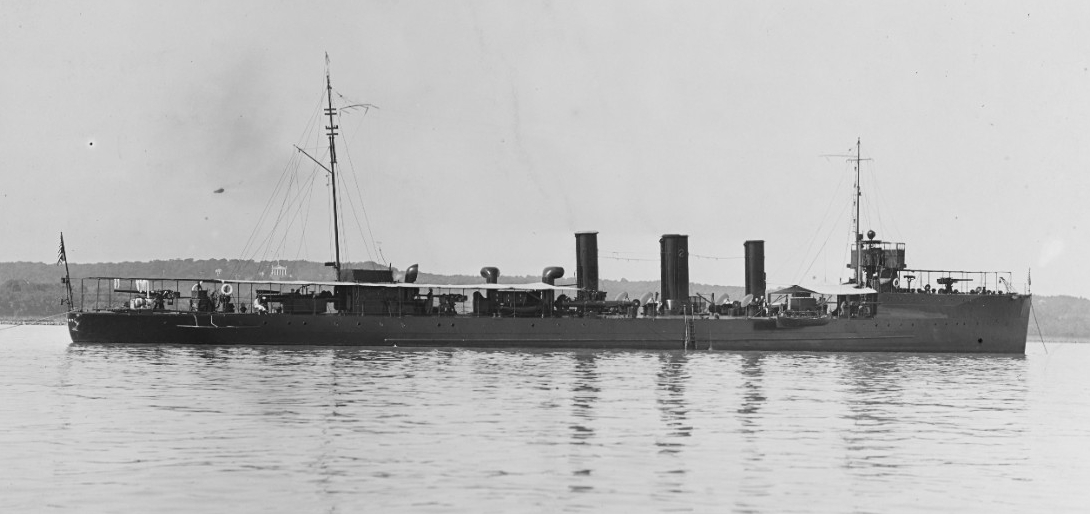
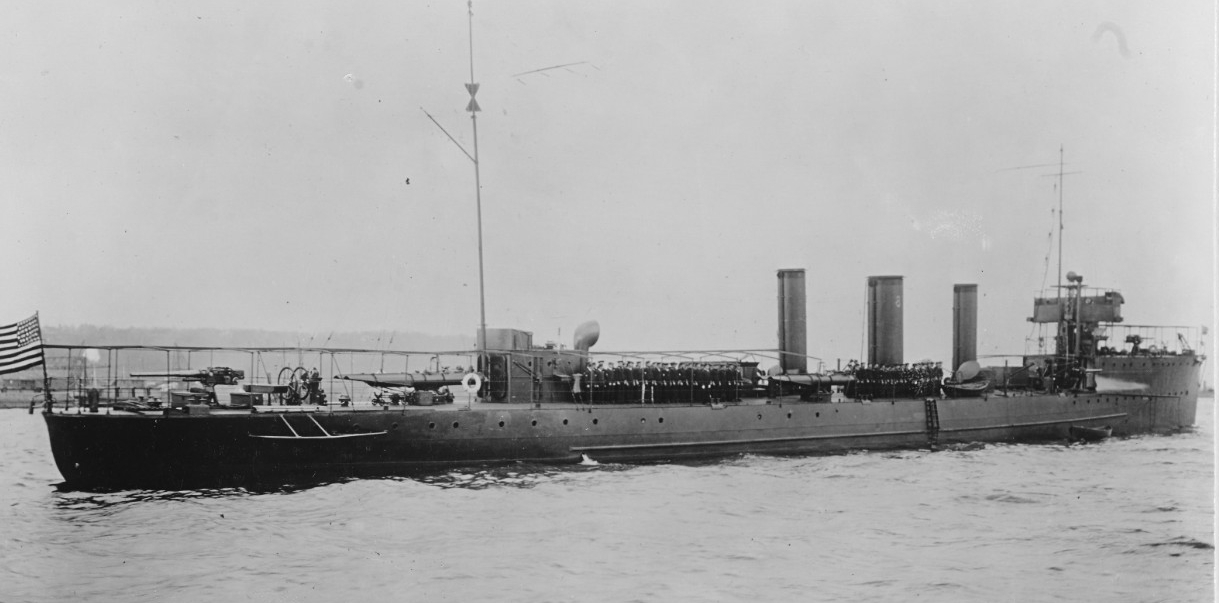
By 1 January 1916, Terry was operating with a reduced complement in the destroyer division. On the 31st, she cruised with the First Flotilla, Destroyer Force, Atlantic Fleet, to Key West, Fla. In May, she steamed to Santo Domingo [Dominican Republic]. On 10 June, while maneuvering in the inner harbor at Puerto Plata, she struck a reef and settled until the greater part of the main deck was submerged. Rear Adm. Albert Gleaves, Commander, Destroyer Force, Atlantic Fleet, in a subsequent report, noted that “The accident of the Terry proves the inadvisability of detailing these vessels to foreign service inadequately manned…” Under the supervision of the commanding officer of Sacramento (Gunboat No. 19), Terry’s officers and men joined the staff of a wrecking company in salvaging the ship on 13 June and freed her on the 26th. She was then temporarily repaired by 7 July, and towed by the tug Relief, of the Merritt & Chapman Derrick & Wrecking Company, to the Charleston Navy Yard. Arriving on 15 July, Terry entered the yard to undergo repairs that same day.
The United States declared war on Germany and entered the World War on 6 April 1917. At the time, Terry still lay in yard hands at Charleston. The next day she underwent trials and by 11 April, her major work having been completed, could leave the yard. The next day [12 April], she was ordered to proceed to Newport. Departing that same day, however, leaks in her condensers compelled her to return to Charleston for additional work. Returning to the yard on 13 April, the ship underwent repairs that enabled her able to get underway and rejoin the fleet.
The Office of the Chief of Naval Operations, on 7 May 1918, organized destroyers intended for distance service into designated divisions, placing Terry in Destroyer Division Four along with Allen (Destroyer No. 66), Jarvis (Destroyer No. 38), Fanning (Destroyer No. 36), McCall (Destroyer No. 28), and Perkins (Destroyer No. 26). Prior to deploying to Europe, Terry patrolled along the Atlantic coast and escorted merchantmen. Having made her way to the New York Navy Yard, Terry got underway on 26 May with Allen and McCall to proceed up the East River bound for Long Island Sound. While passing through Hell Gate, however, Allen touched ground. As a result, all three returned to the New York Navy Yard that same day and Allen went into dry dock that evening.
On 14 June 1917, the first American Expeditionary Force convoy sailed in four groups from New York bound for St. Nazaire, France. Group 1 consisted of Seattle (Armored Cruiser No. 11), the armed yacht Corsair (S. P. 159), Terry, Wilkes (Destroyer No. 67), and Roe (Destroyer No. 24), the troop transport DeKalb (Id. No. 3010), and U.S. Army Transports (USAT) Tenadores, Saratoga, Havana, and Pastores. On 23 June, Cushing (Destroyer No. 55), Jacob Jones (Destroyer No. 61), Conyngham (Destroyer No. 58), Nicholson (Destroyer No. 52), and O’Brien (Destroyer No. 51) stood out of Queenstown [Cobh], Ireland, and rendezvoused with Group 1, now composed of Seattle, DeKalb, Wilkes, Terry, Roe, Tenadores, Saratoga, Havana, and Pastores and escorted the ships to France.
On 23 December 1917, Terry lay at the New York Navy Yard, having returned from Europe after a second ocean convoy escort mission. She received orders from the Commander in Chief, Atlantic Fleet to report to the troop transport Hancock at Philadelphia. Departing the next day, she arrived, at Philadelphia a day later, on Christmas Day. Although scheduled to depart earlier, along with Beale (Destroyer No. 40), the ships did not get underway due to extreme cold, until 9 January 1918. Hancock sailed with Rear Adm. Herbert O. Dunn, a Staff Aviation Company, and a U.S. Marine guard detachment of 50 men with two 7-inch guns intended for the defense of Ponta Delgada, embarked. The ships arrived at Horta, Azores, on 19 January, without incident. Two days later, all three ships stood down the coast toward Ponta Delgada, reaching their destination on the 22nd.
On 26 January 1918, Terry and Beale received follow-up orders to proceed to Queenstown (Base No. 6) after escorting the troop transport Buford (Id. No. 3818) to France. Terry, Beale, and Buford steamed for St. Nazaire on the 28th. Having completed their mission, both destroyers departed St. Nazaire on 4 February and reached Queenstown on the 5th. From this base, she was to escort convoys through the submarine-infested “Danger Zone” surrounding the British Isles.
On 19 March 1918, Terry assisted Manley (Destroyer No. 74) with the latter’s casualties after that destroyer suffered an accidental depth charge explosion. Taking 38 of Manley’s crew on board, Terry transported them to Queenstown. The following month (25-26 April), Terry patrolled Area 6 off the entrance to Queen’s Channel, Liverpool, England, with orders to rendezvous with the British cargo vessel War Patriot and escort her to Queenstown. Prior to the rendezvous, the destroyer dropped eight depth charges in the swept channel, even though at 10 fathoms it was believed to be too shallow for a submarine. The detonations produced negative results. Terry found her charge to be a challenge, however, since War Patriot did not adhere closely to the prescribed zigzag patterns, slowing her progress and exposing her to potential attack, but both ships reached Queenstown late in the morning on the 27th without incident.
Terry received orders and got underway in company with Wilkes from Queenstown on 1 June 1918. Having stood out of the harbor, however, she was unable to locate Wilkes. While searching to make contact, she received a message that a submarine had been sighted. There was, however, a number of friendly destroyers operating in the area and a series of wireless messages by higher authorities regarding this sighting caused confusion. At 8:48 a.m., Terry sighted a suspicious object forward of her starboard beam, and turned toward what appeared to be a submarine exuding heavy white smoke and moving at high speed away from her. Consequently, Terry fired a shot well over. With no recognition signal still forthcoming, the destroyer fired a salvo from two of her forward guns. With the rounds landing in proximity to her, the submarine lay-to and rendered the proper signal. Terry ceased fire and approached cautiously, finding, upon closer examination, the submarine to be L-4 (Submarine No. 43) (Lt. Garnet Hulings commanding) out of Queenstown, her conning tower bearing the designation AL-4 given the need to differentiate the Americans’ L-boats from similarly designated L-boats of the Royal Navy. The destroyer signaled her about the reported presence of a German U-boat in the area and also informed the submarine that she was 30 miles west of her assigned patrol sector. Terry continued her patrol without further incident.
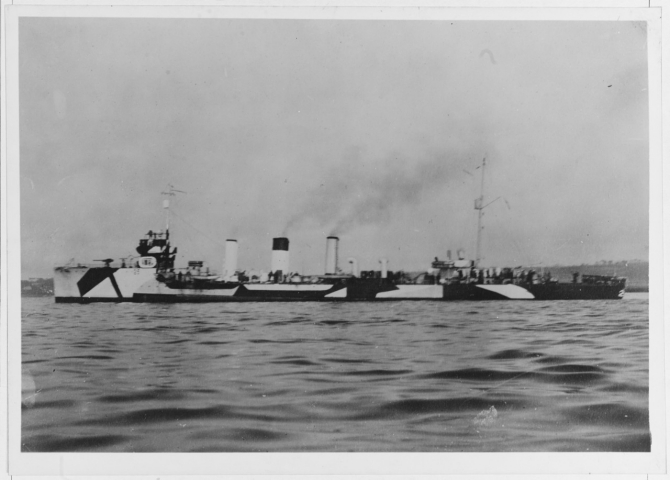
Terry, photographed in 1918 in “dazzle” camouflage. (Naval History and Heritage Command Photograph NH 41807)
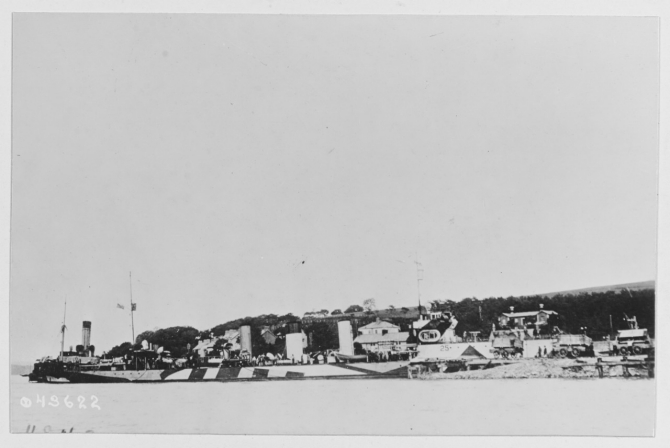
Terry, her bow obscured, in a British port, 1918. Note her starboard side pattern camouflage. (U.S. Army Signal Corps Photograph 111-SC-43622, National Archives and Records Administration, Still Pictures Division, College Park, Md.)
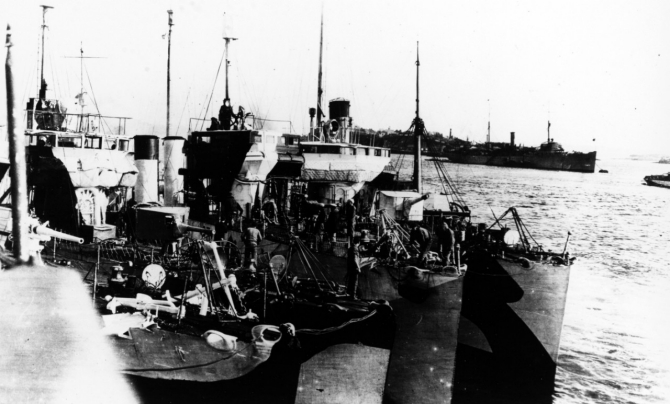
Queenstown, Ireland, 1918. Third ship from the left (just inboard of the outboard destroyer) is Terry. Melville (Destroyer Tender No. 2) is in the right background. Courtesy of Jack Howland, 1982. (Naval History and Heritage Command Photograph NH 93723)
Terry, while escorting a convoy on 9 July 1918, responded to the report of the sinking of the Le Havre, France-bound British steamer Mars which had been struck by two torpedoes from the German submarine U- 92 (Kapitänleutnant Günther Ehrlich) the previous day. Having dropped depth charges, Jenkins picked up the survivors while Terry circled and provided cover for the rescue. On 24 July 1918, Terry cleared Queenstown for Liverpool. She entered the Cammell-Laird yard and underwent a refit well into August, after which resumed patrol and escort duties operating from Base No. 6.
The British Admiralty and the U.S. Navy Department agreed to a plan on 10 October 1918, to protect troop convoys upon receipt of reports that German battlecruisers had broken out into the Atlantic. With two troop convoys en route to France, on 14 October, Rear Adm. Thomas S. Rodgers ordered Battleship Division Six, Utah (Battleship No. 31), Nevada (Battleship No. 36), and Oklahoma (Battleship No. 37), with a screen of seven destroyers, Terry, Downes (Destroyer No. 45), Conyngham, Allen, Beale, Stevens (Destroyer No. 86), and Sampson (Destroyer No. 63), to depart Berehaven, Ireland, and rendezvous with the convoys. The battleships and escorting destroyers made contact with both inbound elements, respectively, and in each instance escorted them into the danger zone. Once through, the battleships were detached from each and allowed the destroyers to escort them into port. Despite reports to the contrary, the German ships never sortied and posed no danger to the transports. This was the only sortie by Battleship Division Six to protect troop convoys.
On 18 October, Terry was escorting Convoy OLX-50 in company with HMS Flying Fox and five U.S. destroyers, when HMS Almanzora a ship in the convoy, signaled, “Submarine sighted on starboard hand.” Terry maneuvered and dropped twelve depth charges on a suspicious oil slick with no apparent result. Flying Fox similarly maneuvered and dropped a barrage of depth charges with like results. Afterward, the convoy proceeded through the Irish Sea with no further incident. Within weeks, on 11 November 1918, the Armistice went into effect effectively ending hostilities.
Terry cleared Queenstown to return to the U.S. on 16 December 1918. Upon her return home, she underwent a period of maintenance, and over the ensuing months, rarely got underway. After eleven months of that extremely limited operational service since her return from the war, she was decommissioned at the Philadelphia Navy Yard on 13 November 1919. While in a reserve status the destroyer was re-designated DD-25 on 17 July 1920, as part of a Navy-wide administrative re-organization.
Terry remained at the Philadelphia Navy Yard until transferred to the Treasury Department on 7 June 1924 as one of 31 destroyers transferred for service with the U.S. Coast Guard in the enforcement of the 18th Amendment (Prohibition). Adapting those ships was thought to be less costly than building new ones. In the end, however, the rehabilitation of the vessels became a saga in itself because of the exceedingly poor condition of many of the war-weary destroyers. It took nearly a year to remove the installed torpedo and antisubmarine equipment and bring the ships up to seaworthiness and operational capacity. Additionally, the destroyers were by far the largest and most sophisticated vessels ever operated by the Coast Guard; trained crewmen were nearly non-existent. As a result, Congress subsequently authorized hundreds of new enlisted billets. It was these inexperienced recruits that generally made up the destroyer crews.
Retaining her name, Terry was re-designated CG-19. She underwent trials in May 1925 and conducted her shakedown cruise off the Delaware capes prior to being commissioned at the Philadelphia Navy Yard on 30 June 1925, Lt. Cmdr. Eugene A. Coffin, USCG in command. Assigned to the Coast Guard’s Destroyer Force, she departed Philadelphia on 31 July and reported to New London, Conn. en route to her duty station with Division Three at Boston, Mass. While Terry was capable of well over 25 knots, seemingly an advantage in the interdicting of rumrunners, she was easily outmaneuvered by smaller vessels. As a result, the destroyer picketed the larger supply ships (“mother ships”) on “Rum Row” in an attempt to prevent them from off-loading their illicit cargo onto the smaller, speedier contact boats that ran the liquor into shore.
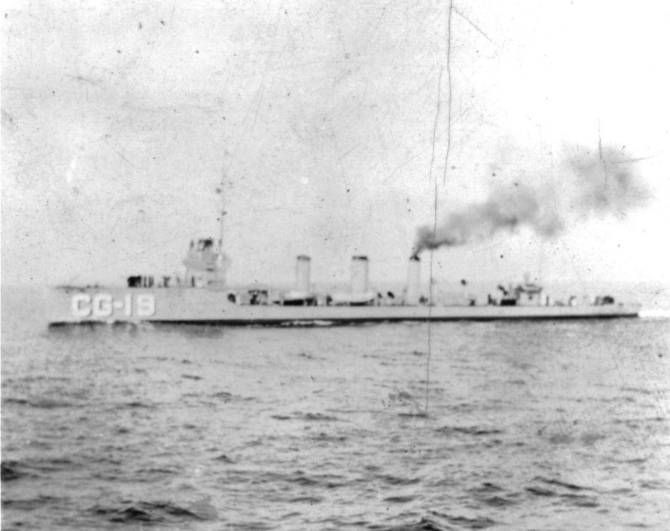
Undated view of Terry underway in Coast Guard service as CG-19. (Official Coast Guard Photograph, Terry Cutter File, USCG Historian’s Office)
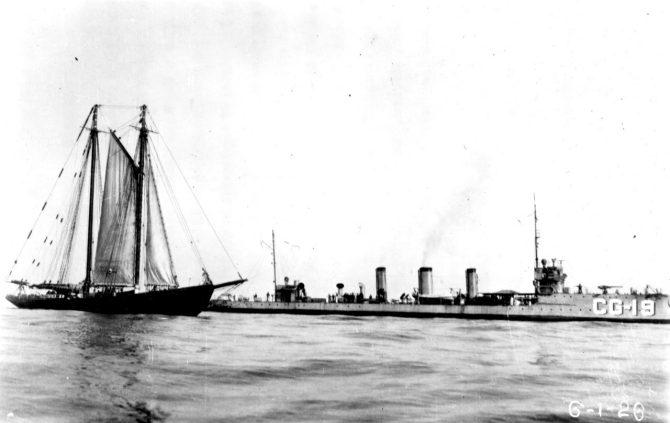
Terry pickets the French-flagged rumrunner Mistinguette out of St. Pierre et Miquelon, dated 20 June 1926. (Official Coast Guard Photograph, Terry Cutter File, USCG Historian’s Office)
Within the first year of her commissioned service with the Coast Guard, Terry participated in the battle practices for Gunnery Year 1925-1926. She rated 13th among the 22 destroyers and cutters in the competition. A year later, Gunnery Year 1926-1927, her standing improved to fifth overall, for the 16 destroyers competing. Her performance in both the Short-Range and Long-Range battle practices was remarkably consistent as she stood fifth in both. That performance fell off markedly during the Gunnery Year 1928-1929 competition, as she rated just 15th among the 24 destroyers in the competition.
Ultimately, Terry’s grueling anti-smuggling interdiction duties off the Eastern seaboard wore upon her and over time she, along with her fellow former-Navy destroyers, had become unfit for service. She received orders placing her in ordinary at New London, Conn., on 1 April 1930 along with Patterson (CG-16), Monaghan (CG-15), McCall (CG-14), and Fanning (CG-11). She was decommissioned on 12 August and ordered towed back to Philadelphia Navy Yard. Terry was returned to the Navy on 18 October 1930 and restored on the Navy list in a decommissioned status, listed as a "vessel to be disposed of by sale or salvage." Terry was sold on 2 May 1934, to Michael Flynn, Inc., Brooklyn, N.Y. for scrapping in accordance with the London Naval Treaty for the Reduction of Naval Armament. Her name was stricken from the Navy Register on 28 June 1934.
| Commanding Officers | Dates of Command |
| Lt. Cmdr. Martin E. Trench | 18 October 1910 – 18 May 1911 |
| Lt. Cmdr. John C. Fremont | 18 May 1913 – 28 June 1913 |
| Lt. George P. Brown | 28 June 1913 – 26 September 1913 |
| Lt. Richard C. Saufley | 26 September 1913 – 6 November 1913 |
| Ens. Bernard O. Wills | 6 November 1913- 10 December 1913 |
| Ens. Wallace B. Phillips | 10 December 1913 – 28 April 1914 |
| Lt. Cmdr. Ernest J. King | 28 April 1914 – 17 July 1914 |
| Ens. Wallace B. Phillips | 17 July 1914 – 8 August 1914 |
| Lt. Aubrey W. Fitch | 8 August 1914 – 25 September 1914 |
| Lt. Cmdr. Arthur L. Bristol | 25 September 1914 – 21 August 1915 |
| Lt. William S. Nicholas | 21 August 1915 – 2 April 1917 |
| Lt. (j.g.) Delavan B. Downer | 2 April 1917 - 7 April 1917 |
| Lt. Cmdr. John F. Shafroth Jr. | 7 April 1917 – 4 September 1918 |
| Lt. Cmdr. Robert E. Rogers | 4 September 1918 – 24 January 1919 |
| Lt. (j.g.) Brainbridge D. Folwell | 24 January 1919- 31 January 1919 |
| Lt. (j.g.) Frank A. Saunders | 31 January 1919- 17 February 1919 |
| Lt. (j.g) George B. Wilson | 17 February 1919- 12 March 1919 |
| Lt. (j.g.) Frank A. Saunders | 12 March 1919- 18 March 1919 |
| Lt. Cmdr. Robert M. Doyle Jr. | 18 March 1919 – 9 June 1919 |
| Lt. (j.g.) David H. Clark | 9 June 1919- 13 November 1919 |
| Lt. Cmdr. Eugene A. Coffin, USCG | 30 June 1925 – 22 May 1928 |
| Lt. Cmdr. Robert M. Kaufholz, USCG | 22 May 1928 – 10 December 1929 |
| Lt. Robert E. Hunter, USCG | 10 December 1929 – 12 August 1930 |
Christopher B. Havern Sr.
30 January 2017


